The goal of jamba is to provide useful custom functions for R data analysis and visualization.
A full online function reference is available via the pkgdown documentation:
Functions are categorized, some examples are listed below:
The R functions in jamba have been built up over several years, often
based upon and citing the relevant discussion from Stackoverflow,
R-help, or Bioconductor, along with the principal author(s). Almost
every function is some sort of wrapper around existing R functions –
designed for specific cases where I can make it faster, more flexible,
or customized to make my analysis life easier. Kudos and thanks to the
original authors! The R community is built upon the collective
greatness of its contributors!
Most of the functions are designed around workflows for Bioinformatics analyses, where functions need to be efficient when operating over 10,000 to 100,000 elements. (They work really well with millions as well.) Usually the speed gains are obvious with about 100 elements, then scale linearly (or worse) as the number increases. I and others use these functions all the time.
One example function writeOpenxlsx() is a simple wrapper around very
useful openxlsx::write.xlsx(). Also writeOpenxlsx() applies column
formatting for things like P-values, fold changes, log2 fold changes,
numeric and integer values – and uses color-shading of cells for each
type. So many hours saved from hand-editing Excel formats!
Small and large efficiencies are used wherever possible. For example it is faster to operate on unique entries from a 100,000 element list, than it is to perform a function on the full list. In most cases, I have tested numerous available R methods and packages, and settled on the fastest* available at the time. If there is something faster or better, I would love for you to let me/us know!
The functions in jamba are intended to be convenient wrappers around
whatever series of steps it takes to get the job done. My design goal is
to “make my own analysis jobs easier” as first priority.
- If I don’t find it useful, nobody else will.
- And even if nobody else finds it useful, at least I do!
Lastly, jamba should motivate me and others to create R packages
instead of a random collection of R functions in *.R files.
mixedSort()- highly efficient alphanumeric sort, for example chr1, chr2, chr3, chr10, etc.mixedSortDF()- as above, applied to columns in adata.frame(ormatrix,tibble,DataFrame, etc.)mixedSorts()- as above, applied to a list of vectors with no speed loss.
Example:
| miRNA | sort_rank | mixedSort_rank | |
|---|---|---|---|
| 2 | ABCA2 | 2 | 1 |
| 1 | ABCA12 | 1 | 2 |
| 3 | miR-1 | 3 | 3 |
| 6 | miR-1a | 6 | 4 |
| 7 | miR-1b | 7 | 5 |
| 8 | miR-2 | 8 | 6 |
| 4 | miR-12 | 4 | 7 |
| 9 | miR-22 | 9 | 8 |
| 5 | miR-122 | 5 | 9 |
These functions help with base R plots, in all those little cases when
the amazing ggplot2 package is not a smooth fit.
nullPlot()- convenient “blank” base R plot, optionally displays marginsplotSmoothScatter()- smooth scatterplot()for point density, enhanced oversmoothScatter()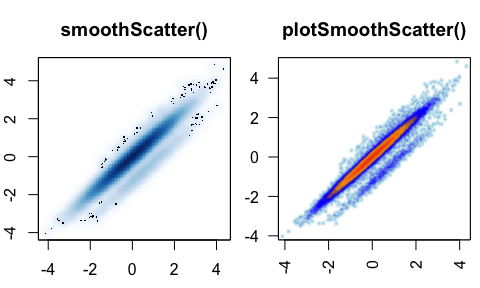
plotPolygonDensity()- fast density/histogram plot for vector or matrix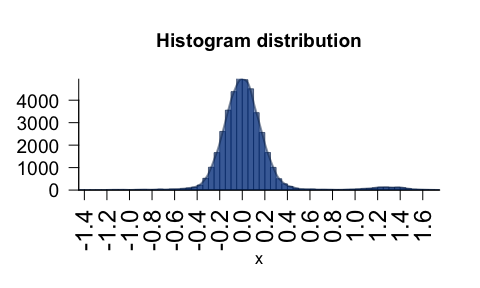
imageDefault()- enhancedimage()that enables raster output with consistent pixel aspect ratio.imageByColors()- wrapper toimage()for a matrix or data.frame of colors, with optional labels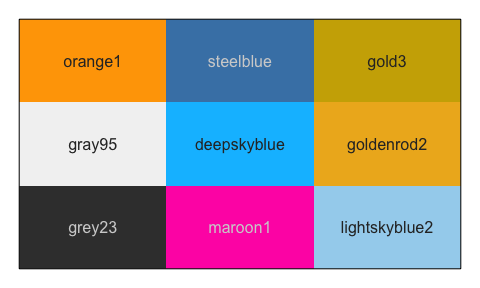
minorLogTicksAxis()- log-transformed axis labels, flexible log base, and option for properly adjustedlog2(1 + x)format.sqrtAxis()- draw a square-root transformed axis, with proper labels.drawLabels()- draw square colorized text labelsshadowText()- replacement fortext()that draws shadows or outlines.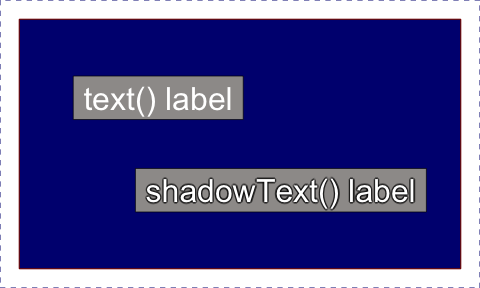
groupedAxis()- grouped axis labels to show regions/rangesdecideMfrow()- determine appropriate value forpar("mfrow")for multipanel output in base R plotting.getPlotAspect()- determine visible plot aspect ratio.
Every Bioinformatician/statistician needs to write data to Excel, the
writeOpenxlsx() function is consistent and makes it look pretty. You
can save numerous worksheets in a single Excel file, without having to
go back and custom-format everything.
writeOpenxlsx()- flexible Excel exporter, with categorical and conditional colors.applyXlsxCategoricalFormat()- apply categorical colors to ExcelapplyXlsxConditionalFormat()- apply conditional colors to Excel
Everything I do uses color to the utmost limit, especially on R console, and in every R plot.
getColorRamp()- flexible to create or retrieve color gradientswarpRamp()- “bend” a color gradient to enhance the visual rangecolor2gradient()- convert a color to gradient of n colors; or do the same for a vectormakeColorDarker()- adjust darkness and saturationshowColors()- display a vector or list of colorsfixYellow()- adjust the weird green-yellow, by personal preferenceprintDebug()- pretty colorized text output usingcrayonpackage.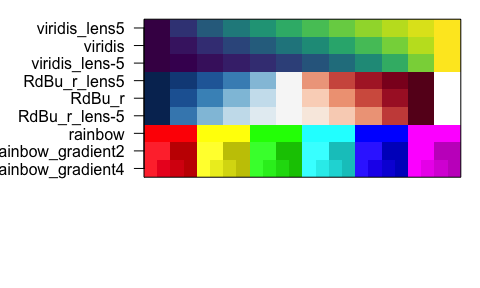
Cool methods to operate on super-long lists in one call, to avoid
looping through the list either with for() loops, lapply() or
map() functions.
cPaste()- highly efficientpaste()over a large list of vectorscPasteS()- as above but usingmixedSort()beforepaste().cPasteU()- as above but usinguniques()beforepaste().cPasteSU()- as above but usingmixedSort()anduniques()beforepaste().uniques()- efficientunique()over a list of vectorssclass()- runsclass()on a listsdim(),ssdim()- dimensions of list objects, or nested list of listsrbindList()- efficientdo.call(rbind, ...)to bind rows into a matrix or data.frame, useful when followingstrsplit().mergeAllXY()- merge a list ofdata.frameobjectsrmNULL()- remove NULL or empty elements from a list, with optional replacement
We use R names as an additional method to make sure everything is kept in the proper order. Many R functions return results using input names, so it helps to have a really solid naming strategy. For the R functions that remove names – I highly recommend adding them back yourself!
makeNames()- make unique names, using flexible logicnameVector()- add names to a vector, using its own value, or supplied namesnameVectorN()- make named vector using the names of a vector (useful insidelapply()) or any function that returns data using names of the input vector.
pasteByRow()- fast, flexible row-paste with delimiters, optionally remove blankspasteByRowOrdered()- as above but returns ordered factor, using existing factor orders from each column when presentrowGroupMeans(),rowRmMadOutliers()- efficient grouped row functionsmergeAllXY()- merge a list ofdata.frameinto onerenameColumn()- rename columnsfromandto.kable_coloring()- flexible colorizeddata.frameoutput in Rmarkdown.
gsubOrdered()- gsub that returns ordered factor, maintians the previous factor ordergrepls()- grep the environment (including attached packages) for object namesvgrep(),vigrep()- value-grep shortcutunvgrep(),unvigrep()- un-grep – remove matched results from the output.provigrep()- progressive grep, searches each pattern in order, returning results in that orderigrepHas()- rapid case-insensitive grep presence/absense testucfirst()- upper-case the first letter of each word.padString(),padInteger()- produce strings from numeric values with consistent leading zeros.
noiseFloor()- apply noise floor (and ceiling) with flexible replacement valueswarpAroundZero()- warp a numeric vector symmetrically around zerorowGroupMeans(),rowRmMadOutliers()- efficient grouped row functionsdeg2rad(),rad2deg()- convert degrees to radiansrmNA()- remove NA values, with optional replacementrmInfinite()- remove infinite values, with optional replacement.formatInt()- convenientformat()for integer output, with comma-delimiter by default
jargs()- pretty function arguments, optional pattern search argument name
jargs(plotSmoothScatter)
#> x = ,
#> y = NULL,
#> bandwidthN = 300,
#> transformation = function( x ) x^0.25,
#> xlim = NULL,
#> ylim = NULL,
#> nbin = 256,
#> nrpoints = 0,
#> colramp = c("white", "lightblue", "blue", "orange", "orangered2"),
#> doTest = FALSE,
#> fillBackground = TRUE,
#> naAction = c("remove", "floor0", "floor1"),
#> xaxt = "s",
#> yaxt = "s",
#> add = FALSE,
#> applyRangeCeiling = TRUE,
#> useRaster = TRUE,
#> verbose = FALSE,
#> ... =sdim(),ssdim()- dimensions of list objects, or nested list of listssdima()- runssdim()on the attributes of an object.isTRUEV(),isFALSEV()- vectorized test for TRUE or FALSE values, sinceisTRUE()only operates on single values, and does not allowNA.
printDebug()- pretty colorized text output usingcrayonpackage.setPrompt()- pretty colorized R console prompt with project name and R versionnewestFile()- most recently modified file from a vector of files
jamma– MA-plots (also known as “mean-variance”, “Bland-Altman”, or “mean-difference” plots), relies uponjamba::plotSmoothScatter();centerGeneData()to apply flexible row-centering with optional groups and control samples;jammanorm()- normalize data based upon MA-plot outputcolorjam–colorjam::rainbowJam()for scalable categorical colors using alternating luminance and chroma values.genejam– fast, consistent conversion of gene symbols to the most current gene nomenclaturesplicejam– Sashimi plots for RNA-seq datamultienrichjam– multiple gene set enrichment analysis and visualizationplatjam– platform technology functions, importers for NanoString